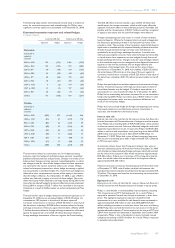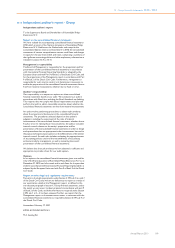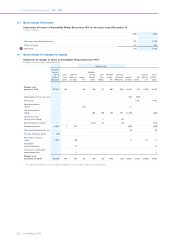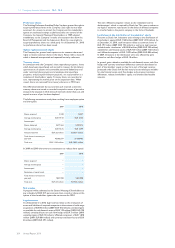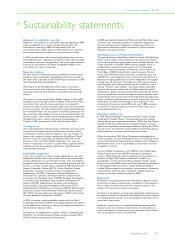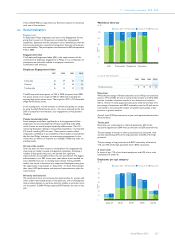Philips 2010 Annual Report Download - page 207
Download and view the complete annual report
Please find page 207 of the 2010 Philips annual report below. You can navigate through the pages in the report by either clicking on the pages listed below, or by using the keyword search tool below to find specific information within the annual report.
15 Sustainability statements 15 - 15
Annual Report 2010 207
15 Sustainability statements
Approach to sustainability reporting
Philips has a long tradition of sustainability reporting, beginning in 1999
when we published our first environmental annual report. We
expanded our reporting in 2003 with the launch of our first
sustainability annual report, which provided details of our social and
economic performance in addition to our environmental results.
In 2011 we published our third annual integrated financial, social and
environmental report, reflecting the progress we have made to embed
sustainability in our way of doing business. This is also supported by the
inclusion of sustainability in the Philips Management Agenda and in
Vision 2015, our 5-year strategic plan.
Reporting standards
We have followed relevant best practice standards and international
guidelines while compiling the sustainability performance covered in
this report. Most important are the Global Reporting Initiative’s (GRI)
G3 Sustainability Reporting Guidelines.
With regard to the GRI Application Levels system, we assessed
ourselves at the A+ level. A detailed overview of our Management
Approach and the G3 Core Indicators is provided at the end of this
section.
We signed on to the United Nations Global Compact in March 2007,
joining thousands of companies from all regions of the world as well as
international labor and civil society organizations to advance 10
universal principles in the areas of human rights, labor, the environment
and anti-corruption. Our General Business Principles, Sustainability and
Environmental Policies, and our Supplier Sustainability Declaration are
the cornerstones that enable us to live up to the standards set by the
Global Compact. This is closely monitored and reported, as illustrated
throughout this report, which is our annual Communication on
Progress (COP) submitted to the UN Global Compact Office.
Tracking trends
We continuously follow external trends to determine the issues most
relevant for our company and those where we can make a positive
contribution to society at large. In addition to our own research, we
make use of a variety of sources, including the World Bank, World
Business Council for Sustainable Development (WBCSD), World
Economic Forum and World Health Organization. Our work also
involves tracking topics of concern to governments, regulatory bodies,
academia, and non-governmental organizations, and following the
resulting media coverage.
Stakeholder engagement
Across all our activities we seek to engage stakeholders to gain their
feedback on specific areas of our business. Working in partnerships is
crucial in delivering on our commitment to bring “sense and simplicity”
to people’s health and well-being. We participate in meetings and task
forces as a member of organizations including the WBCSD, Electronic
Industry Citizenship Coalition (EICC), Carbon Disclosure Project
Supply Chain, European Committee of Domestic Equipment
Manufacturers (CECED), Federation of National Manufacturers
Associations for Luminaires and Electrotechnical Components for
Luminaires in the European Union (CELMA), European Coordination
Committee of the Radiological, Electromedical and Healthcare IT
Industry (COCIR), Digital Europe, European Lamp Companies
Federation (ELC), European Roundtable of Industrialists (ERT),
National Electrical Manufacturers Association (NEMA), Environmental
Leadership Council of the Information Technology Industry Council
(ELC ITIC), Consumer Electronics Association (CEA) and Association
of Home Appliance Manufacturers (AHAM).
In 2010, we started a multi-stakeholder initiative with the Dutch
Sustainable Trade Initiative (IDH), the leading Dutch labor union (FNV)
and GoodElectronics focusing on improving working circumstances in
the electronics industry in China.
Furthermore, we engaged with a number of NGOs including Enough,
MakeITfair, the Chinese Institute of Public and Environmental Affairs,
SOMO, Amnesty International and Greenpeace.
In 2009 we established a dedicated Professional and Public Affairs team
to further steer and professionalize our stakeholder engagement
activities with key business influencers including government, non-
governmental institutions, industry associations, industry partners,
influencers and opinion formers.
The Philips Center for Health and Well-being
Through the creation of the Philips Center for Health and Well-being,
Philips seeks to address key societal issues and solutions on themes
such as healthy and active aging, livable cities and healthy lifestyles. The
Center launched in December 2009 and brings together teams of
multidisciplinary experts from all over the world in think tanks.
Participants include EU Members of Parliament, NGOs such as the
World Bank, UNICEF, Global Health Council, European Patient’s
Forum, ISOCARP (international association of urban planners), and
WBCSD. The active aging think tank is working from the USA and is
debating how aging populations can remain independent and engaged
through their life transitions. The livable cities think tank is working
from Singapore, and is taking a holistic view of a livable city – and is
defining “livability” which includes a city being resilient, sustainable,
authentic and inclusive. Additionally, the Philips Index for Health &
Well-being is a global research project being conducted by the Center.
It aims to identify what citizens find important concerning their health
and well-being. The research examines the mega-trends that shape each
nation’s healthcare, lifestyle and who we are as a society, with a focus on
what aspects of health and well-being are most important. It was
conducted in 23 countries during 2010, with over 31,000 consumers
surveyed. For more information on the work of the Center, go to
www.philips-thecenter.org.
Working on global issues
In 2010, Philips participated in the United Nations Climate Change
Conference in Cancun, Mexico. We partnered with other leading
industry players, governmental organizations, NGOs (like The Climate
Group) and the United Nations Environmental Program to create a
global sectoral agreement on phasing out inefficient lighting. At COP16,
this roll-out was welcomed by a range of different stakeholders given its
triple benefits for consumers, environment and economy.
Philips also signed the CEO Water Mandate acknowledging that in
order to operate in a more sustainable manner, and contribute to the
vision of the UN Global Compact and the realization of the Millennium
Development Goals, it has a responsibility to make water-resources
management a priority.
As part of Philips’ participation in the WBCSD Vision 2050 project,
Philips Research joined the WBCSD Sustainable Consumption
activities. Philips Research hosted a workshop with special focus on
health at the High Tech Campus in Eindhoven, in addition to
participating in a series of cross-industry meetings. Another activity
related to the Vision 2050 project was Philips Research’s participation
in the National Health Service Low Carbon Healthcare dialog in
London. Different types of care providers, care purchasers, community
representatives, and many other stakeholders explored scenarios
towards a low carbon healthcare system by 2030.
Biodiversity
Biodiversity is a complex phenomenon with different elements, such as
preservation of species and ecosystems as enablers for those species to
live in. Impact on biodiversity cannot be measured as easily as, for
instance, CO2 emissions or water consumption.
Furthermore, the impact is to a large extent dependent on the nature of
the business activities, the space used and whether that space is located
in or nearby protected areas. From that perspective the impact of our
operations is very limited.
However, in general there is a trend noticeable that people expect
industry to pay more attention to biodiversity, not only taking into
account the impact of its operations but also the impact of its products.
Our current policy focuses on the following:


